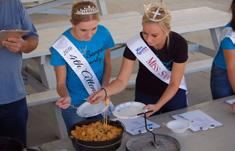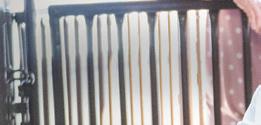
3 minute read
Dutch Oven Cook-Off
SATURDAY, August 21 • 2 p.m.
Prepare now to create that favorite Dutch oven dish using that wonderful secret family recipe, be it a cobbler, casserole, brisket, beans, potatoes or a sinful dessert.
Advertisement
Contestants will be going for top prizes in the annual Sanpete County Fair’s Dutch Oven Cook-Off to be held Saturday, Aug. 21, during the fair.
Don’t worry about a lack of expertise; come join in the Dutch oven food and fun for the afternoon. The cook-off will be held next to the pavilion at the fairgrounds in Manti. Dutch oven cook-off competitors need to bring their completed entry form(s) to the Fairgrounds Pavilion and must be entered by 2 p.m. that day. Judging will begin at 4:30 p.m.
Food will be available to purchase after the judging at $5 per plate with the proceeds going to the Sanpete County Fair. An entry form can be found in the back of this magazine. Extra entry forms will also be available the day of the cook-off at the pavilion.
New to this year’s contest is a special youth category. Youth ages 16 and younger can compete in their own class for a youth award.
DUTCH OVEN HISTORY
Dutch ovens are a distinctive cooking pot that has thick walls and is generally manufactured from cast iron. It may be cast iron with an enameled finish, but it always has a tight-fitting lid.
Dutch ovens have been used for centuries in kitchens around the globe as a cooking vessel. The phrase “Dutch oven” has been around and used for more than 300 years. During the 1600s, the Dutch discovered a significantly better system for producing the molds used to cast these pots using sand, which makes the resulting pots have a far smoother surface area.
Throughout the history of America, the cooking pots have become shallower and legs have been added to better keep the pot above the hot coals in an open fire. Early colonists appreciated the flexibility and sturdiness associated with cast iron. In fact, the ovens were regarded as being so useful that early colonists entered them into their wills.
Rapidly, this new oven came to be greatly valued by American colonists, mainly because its cast-iron construction made the Dutch oven last a long time while its design helped bring about its notable versatility. The truth is, the housewife seldom called for any other sort of pot because the Dutch oven could be employed for boiling, frying, stewing, roasting and baking — all in one pot.
In 1704, a man named Abraham Darby traveled from England to Holland to inspect the Dutch casting process through which brass vessels were cast in dry sand molds. Upon returning to England, Darby experimented with the process and eventually patented a casting process using a better type of molding sand as well as a process of baking the mold to improve casting smoothness. He eventually began casting pots and shipping them to the new colonies and throughout the world.
Others have suggested that early Dutch traders or salesmen peddling cast iron pots may have given rise to the name “Dutch oven.” Still others believe that the name came from Dutch settlers in the Pennsylvania area who used similar cast iron pots or kettles.
SEE DUTCH OVEN COOK-OFF ENTRY FORM ON PAGE 82!

Farmers Floral & Gifts

fl owers and gifts for every occasion
57 West Main | Mount Pleasant 462.2154 | farmersfl oral.com


Quality parts, accessories, paints, tools & supplies. Complete line for cars, trucks, imports, marine & farm equipment
















